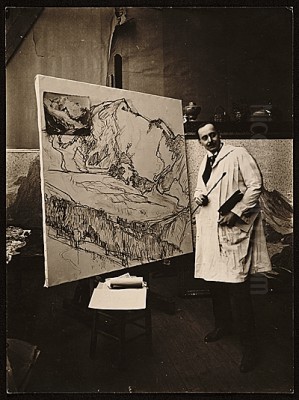
Edgar Alwin Payne stands as a towering figure in American landscape painting, particularly celebrated for his evocative and powerful depictions of the American West. Active during the early to mid-20th century, Payne developed a distinctive style rooted in Impressionism but uniquely his own, characterized by bold compositions, a masterful handling of light and color, and a profound reverence for the natural world. Though largely self-taught, his dedication and innate talent propelled him to the forefront of the California Impressionist movement, leaving behind a legacy of breathtaking canvases that continue to inspire awe and admiration. His journeys took him from the rugged peaks of the Sierra Nevada to the sun-drenched deserts of the Southwest and the majestic Alps of Europe, each location rendered with his signature vitality and atmospheric depth.
Early Life and Artistic Awakening
Born in Washburn, Missouri, in 1883, Edgar Payne's origins were humble, rooted in a farming community far removed from the established art centers of the time. However, a passion for drawing and painting ignited within him at a young age. This artistic calling proved stronger than the pull of agrarian life, and at the tender age of fourteen, Payne made the bold decision to leave home and forge his own path. His early years were marked by itinerant work, taking on various jobs to support himself while honing his craft. He painted houses, created signs, and even designed and painted stage sets for theaters – practical applications of his artistic skills that provided both income and invaluable experience in handling paint and composition on a large scale.
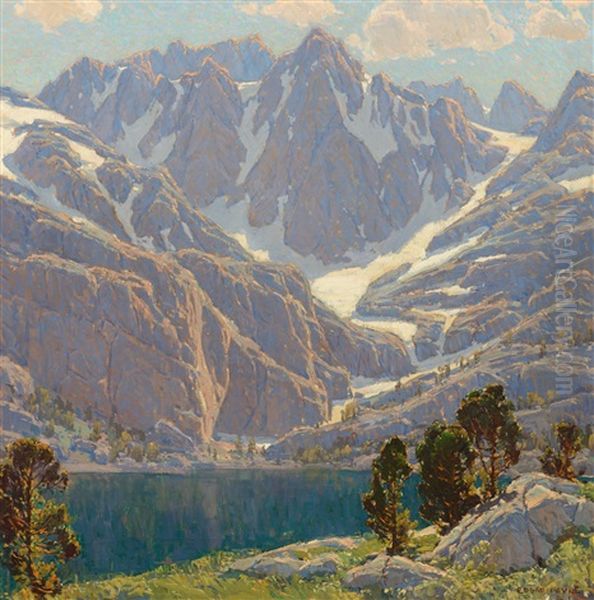
Despite this practical, hands-on learning, Payne did seek some formal instruction. He briefly enrolled at the Art Institute of Chicago, focusing on portraiture. However, the structured, academic environment did not suit his independent spirit and his burgeoning interest in the landscape. Finding the classes too rigid, he soon left, preferring instead the direct study of nature and the lessons learned through personal experimentation and observation. This period solidified his commitment to self-reliance and marked the beginning of his journey as a largely self-taught artist, driven by an internal compass and a deep connection to the world around him.
California Calling: Laguna Beach and a New Direction
Payne's artistic trajectory took a decisive turn towards landscape painting, a shift catalyzed by his travels and his encounters with the dramatic scenery of the American West. While he painted landscapes in the Midwest and elsewhere, a trip to California in 1909 proved transformative. He visited Laguna Beach, then a small, relatively undeveloped coastal village, and was immediately captivated by its unique beauty – the interplay of light on the Pacific Ocean, the dramatic cliffs, and the surrounding hills. This experience resonated deeply with his artistic sensibilities and solidified his focus on landscape painting.
The allure of California was undeniable. Payne returned frequently, drawn by the climate, the quality of light, and the burgeoning community of artists congregating there. He eventually decided to make California his home base. In 1912, while in Chicago, he met and married Elsie Palmer, a talented artist in her own right. Their partnership was both personal and professional; Elsie became a frequent travel companion and fellow artist, sharing his passion for capturing the beauty of the natural world. An anecdote often recounted is that their wedding was postponed by a day, waiting for the "perfect light," a testament to the central role that atmospheric conditions played in their artistic lives. They eventually settled more permanently in the Laguna Beach area, which would become central to Payne's career.
The Laguna Beach Art Colony
The early 20th century saw the rise of several art colonies across the United States, where artists gathered to share ideas, support each other, and paint the local scenery. Laguna Beach emerged as one of the most significant centers for Impressionist painting on the West Coast. Edgar Payne was not just a resident; he became a pivotal figure in this vibrant community. Recognizing the need for a formal organization to promote art in the region, he and Elsie were instrumental in founding the Laguna Beach Art Association (LBAA) in 1918. Payne served as its first president, guiding the association through its formative years.
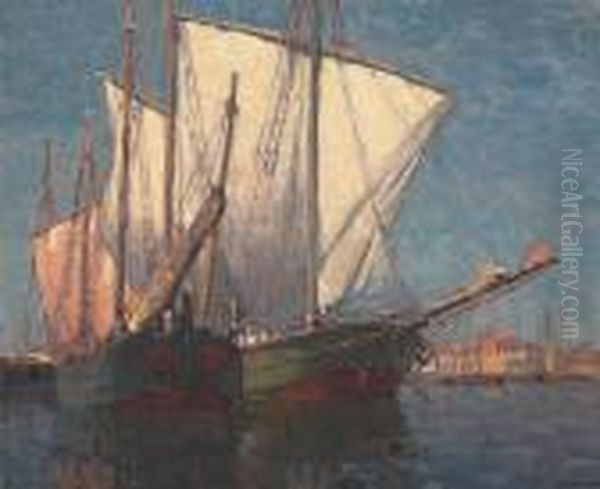
The LBAA provided a crucial platform for artists to exhibit their work, share techniques, and build camaraderie. It helped establish Laguna Beach's reputation as a major art destination. Payne's leadership and his growing national reputation lent significant prestige to the association. He was part of a generation of California Impressionists who adapted the techniques developed in France to the unique light and landscapes of the American West. Artists like William Wendt, often called the "Dean of Southern California landscape painters," Guy Rose, who brought direct experience from Giverny, the home of Claude Monet, Franz Bischoff, known for his vibrant floral and landscape works, and Granville Redmond, the remarkable deaf artist celebrated for his depictions of poppies and coastal scenes, were among his contemporaries shaping the artistic identity of the region. Payne thrived in this environment, contributing significantly to the California plein air movement.
Artistic Philosophy and Technique: Composition of Outdoor Painting
Edgar Payne's approach to painting was grounded in direct observation and plein air (outdoor) practice, a hallmark of Impressionism. He believed strongly in capturing the fleeting effects of light and atmosphere as they appeared in nature. While influenced by the Impressionists' focus on light and broken color, Payne developed a more structured and robust style. His brushwork was often bold and vigorous, applying paint thickly (impasto) in areas to convey texture and form, particularly in his mountain scenes.
He possessed an exceptional ability to simplify complex natural scenes into powerful compositions based on fundamental shapes and masses of color. His understanding of color theory was sophisticated; he masterfully used contrasts of warm and cool colors, and light and dark values, to create depth, drama, and luminosity. His mountain paintings, for instance, often feature strong contrasts between sunlit peaks and shadowed canyons, frequently employing a palette rich in blues, violets, and grays to convey the immense scale and cool air of high altitudes.
Payne's dedication to understanding and teaching the principles of landscape painting led him to write and publish Composition of Outdoor Painting in 1941. This book became an indispensable resource, articulating his theories on composition, color, rhythm, and the simplification of natural forms. It outlined various compositional structures (Steelyard, Circle, S-curve, etc.) illustrated with his own sketches. The book was highly practical and remains influential, valued by artists, students, teachers, and collectors for its clear insights into the art of landscape painting. It codified the knowledge Payne had accumulated through decades of intense observation and practice.
The Majestic Sierras: A Lifelong Fascination
While Payne painted diverse landscapes, the Sierra Nevada mountain range held a special, enduring fascination for him. He made countless pack trips deep into the High Sierras, often accompanied by Elsie, seeking out remote, pristine locations far from civilization. These expeditions were arduous, requiring pack animals to carry supplies and painting gear over challenging terrain. Payne, however, embraced the physical demands, driven by his desire to capture the raw, untamed beauty of these granite peaks, glacial lakes, and alpine meadows.
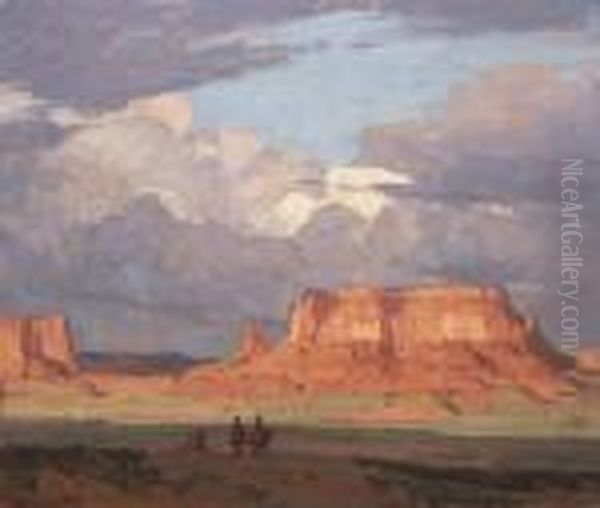
His Sierra paintings are perhaps his most iconic works. He depicted the range in all seasons and weather conditions, from sun-drenched summer days to dramatic, snow-laden winter storms. He was particularly drawn to the monumental scale and geological drama of the mountains. Works often titled with evocative names like The Sierra Divide or Solitude's Enchantment (though specific titles vary, the theme is recurrent) convey a sense of awe and the sublime power of nature. He wasn't merely documenting topography; he aimed to capture the spirit and mood of the mountains. His approach differed significantly from earlier painters of the West like Albert Bierstadt or Thomas Moran, whose Romantic, highly detailed canvases emphasized grandeur through meticulous rendering. Payne, while equally impressed by the scale, used Impressionist techniques to convey the atmospheric effects and the emotional impact of the scene through light and color.
Exploring the Southwest: Deserts and Canyons
Payne's artistic explorations extended beyond California's mountains and coastlines into the dramatic landscapes of the American Southwest. He traveled extensively through Arizona and Utah, drawn to the unique geology and vibrant colors of the region. The Grand Canyon, with its immense scale and complex interplay of light and shadow, became a recurring subject. He also painted the striking mesas and buttes of Monument Valley, capturing their iconic silhouettes against vast desert skies.
His work in the Southwest gained significant exposure through commissions from the Atchison, Topeka and Santa Fe Railway. Like several other prominent artists of the era, Payne was hired by the railway company to create paintings of scenic locations along its routes, particularly focusing on the Grand Canyon and Native American life. These paintings were used in advertising materials, calendars, and posters, promoting tourism to the West. This patronage not only provided Payne with financial support but also brought his depictions of the Southwest to a wide national audience, further cementing his reputation. His work in this region places him in the company of other artists captivated by the desert, such as Maynard Dixon, known for his starkly beautiful desert landscapes, and members of the Taos Society of Artists like Ernest L. Blumenschein and Bert Geer Phillips, who focused on the landscapes and cultures of New Mexico.
European Vistas: Alps, Canals, and Coastlines
Seeking new subjects and inspiration, Edgar and Elsie Payne made several trips to Europe between the 1920s and 1930s. These journeys provided a wealth of new material, allowing Payne to apply his distinctive style to different kinds of landscapes and architectural subjects. He was particularly captivated by the Alps, painting dramatic views in Switzerland and France. His Alpine scenes, such as In the Misty Alps, share the monumental quality of his Sierra paintings but often possess a different atmospheric quality, reflecting the unique light and weather conditions of the European mountains.

He also spent considerable time in Italy, especially Venice and the nearby fishing village of Chioggia. His Venetian scenes often focus on the interplay of light on water, the colorful sails of fishing boats, and the distinctive architecture lining the canals, as seen in works like In the Canal, Chioggia. These paintings showcase his versatility, demonstrating his ability to capture bustling maritime life with the same vigor he applied to mountain wilderness. He also painted along the coast of Brittany in France, capturing harbor scenes like Sardine Boats, Brittany. These European works, while perhaps less numerous than his Western landscapes, are highly regarded and demonstrate the breadth of his artistic vision. His travels place him within a long tradition of American artists, like John Singer Sargent and Mary Cassatt, who sought training and inspiration abroad, though Payne's focus remained firmly on landscape.
Artistic Network, Recognition, and Influence
Throughout his career, Edgar Payne was an active participant in the art world, particularly in California. His role in founding the LBAA and his presidency of the prestigious California Art Club (CAC) in 1926 underscore his leadership status among his peers. The CAC, based in Los Angeles, was another vital organization for Southern California artists, hosting exhibitions and promoting regional art. His involvement connected him with many leading artists of the day.
His wife, Elsie Palmer Payne, was an accomplished artist herself, known for her portraits and genre scenes, often depicting Native American subjects encountered during their travels. Their shared artistic life involved mutual support and critique, and joint expeditions into remote areas. While Edgar focused primarily on landscape, Elsie's work complemented his, offering different perspectives on the places they visited.
Payne received numerous awards and accolades during his lifetime, exhibiting his work widely across the United States. His paintings were acquired by major collectors and museums. Beyond his contemporaries, Payne's work continues to resonate. His bold compositions, expressive use of color, and ability to convey the power of nature have influenced subsequent generations of landscape painters. Modern artists, such as Ben Bauer (as mentioned in the source material), explicitly cite Payne as an inspiration. His approach, balancing Impressionist techniques with strong structural composition, provides a lasting model for capturing the essence of the landscape. His influence can be seen as part of the broader current of American Impressionism, which included East Coast figures like Childe Hassam and Willard Metcalf, who similarly adapted Impressionism to American subjects.
Signature Works: A Glimpse into Payne's Vision
While Payne produced a large body of work, certain paintings stand out as representative of his style and favorite subjects. Titles often reflect the location or mood:
Topmost Trail: Likely depicting a high-altitude scene in the Sierra Nevada, this title evokes the challenging expeditions Payne undertook. Such works typically feature dramatic mountain peaks, perhaps touched by snow, rendered with bold brushwork and a keen sensitivity to atmospheric light, often using cool blues and violets contrasted with warmer tones in sunlit areas. A painting with this title recently commanded significant attention at auction.
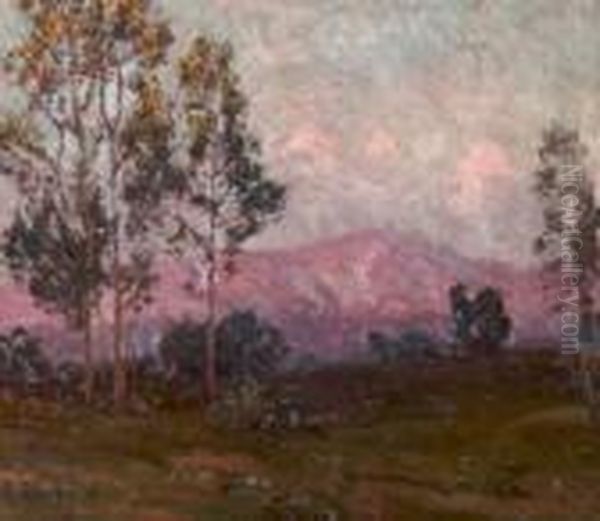
Red Mesa, Monument Valley, Utah: Representing his Southwest period, this work captures the iconic sandstone formations of Monument Valley. Payne excelled at conveying the intense light and arid atmosphere of the desert, using warm earth tones – reds, oranges, ochres – contrasted with the deep blue of the desert sky. The composition likely emphasizes the monumental scale of the mesas against the vast expanse. The Utah Museum of Fine Arts holds a version of this subject.
Sunset, Canyon De Chelly: This title suggests a work focused on the dramatic effects of light at the end of the day in the stunning Canyon de Chelly, Arizona. Payne was a master of capturing sunsets and sunrises, using vibrant, often non-naturalistic colors to convey the intensity of the light and its reflection on the canyon walls. Such paintings highlight his skill in handling transient light effects.
In the Misty Alps: A prime example of his European work, this painting likely portrays the Swiss or French Alps shrouded in atmospheric mist. These works often emphasize mood and mystery, using softer edges and a more muted palette compared to his crisp Sierra scenes, showcasing his ability to adapt his technique to different environments and weather conditions.
Laguna Beach Landscape: Payne painted numerous scenes around his adopted home. These works often capture the coastal bluffs, eucalyptus trees, and the Pacific Ocean under the distinctive California light. They tend to be brighter and warmer in palette compared to his high-mountain subjects, reflecting the coastal environment.
These examples illustrate the range of Payne's subjects and his consistent ability to convey the grandeur, beauty, and specific atmosphere of each location through his unique stylistic lens.
Market, Collections, and Enduring Value
Edgar Payne's work has long been sought after by collectors, and his market remains strong today. His paintings consistently appear at major auctions specializing in American Western Art and California Impressionism, often commanding significant prices. Recent auction results confirm this enduring appeal. For instance, works like Topmost Trail carried pre-sale estimates reaching towards $100,000 in 2024, while In the Misty Alps sold within a $100,000-$140,000 range in 2022. Even smaller studies or works depicting European scenes, like Sardine Boats, Brittany, achieve respectable prices, demonstrating the breadth of collector interest.
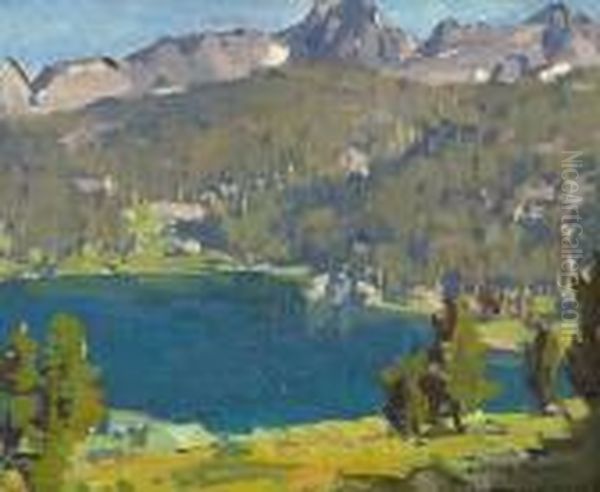
His paintings are held in numerous important public and private collections across the United States. Museums such as the National Academy of Design Museum, the Chicago Art Museum, the Pasadena Art Institute, the Southwest Museum of Los Angeles, and importantly, the Utah Museum of Fine Arts (holding Red Mesa, Monument Valley, Utah), feature his work. The Irvine Museum, dedicated to California Impressionism, also holds significant examples. Numerous private collectors, particularly in California and the West, prize his canvases. This widespread distribution in both public institutions and private hands underscores his established importance in the canon of American art.
Legacy of a Landscape Master
Edgar Alwin Payne passed away in 1947, leaving behind a rich legacy as one of America's premier landscape painters. His contribution extends beyond his stunning canvases; his book, Composition of Outdoor Painting, continues to educate and inspire artists. He was a key figure in the California Impressionist movement and a vital force in the Laguna Beach art colony. More significantly, he developed a powerful and personal vision for depicting the American West, particularly the Sierra Nevada, capturing its majesty and rugged beauty with unparalleled skill and passion.
His ability to combine the light-filled palette of Impressionism with strong, underlying compositional structure gave his work a unique solidity and impact. He conveyed not just the appearance of the landscape, but its inherent energy and grandeur. Through his tireless explorations, his dedication to plein air painting, and his masterful technique, Edgar Payne created an enduring body of work that celebrates the sublime beauty of the natural world and secures his place among the most important American artists of the 20th century. His paintings continue to transport viewers to the luminous peaks and vast horizons he knew and loved so well.